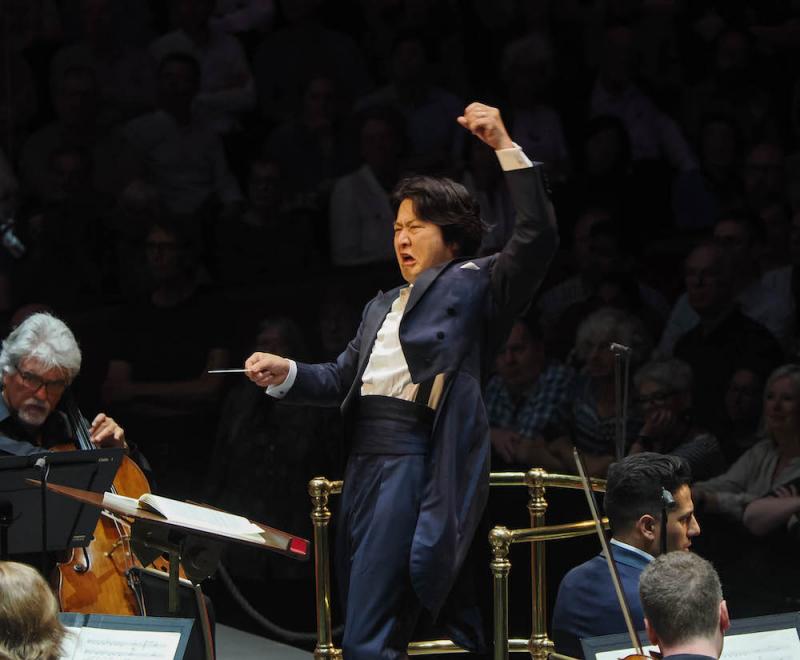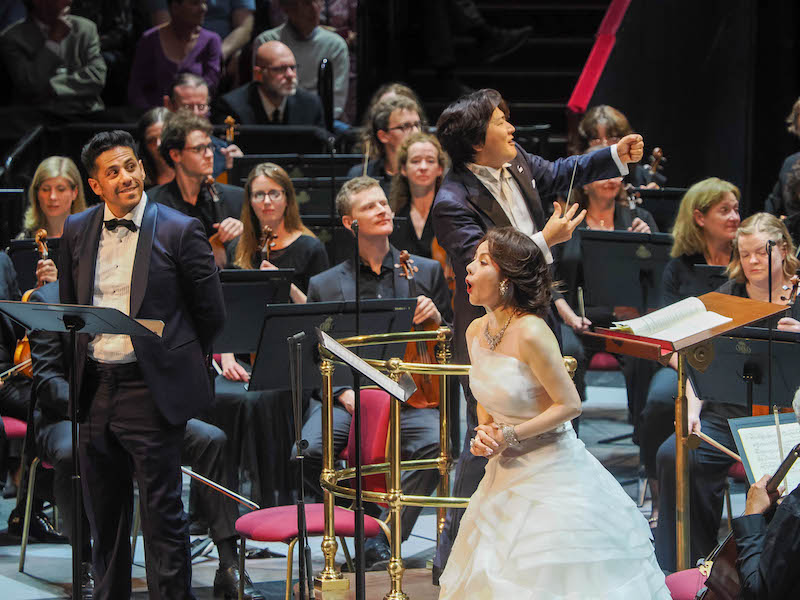Prom 17: CBSO, CBSO Chorus, Yamada review - Carmina Burana presses all the right buttons | reviews, news & interviews
Prom 17: CBSO, CBSO Chorus, Yamada review - Carmina Burana presses all the right buttons
Prom 17: CBSO, CBSO Chorus, Yamada review - Carmina Burana presses all the right buttons
Surefire crowd-pleaser energises more than underwhelming Stravinsky

It stunned me to discover that last night was only the sixth time Carmina Burana had been heard at the Proms. It seems tailor-made for the festival: large-scale and bombastic in a way that fits the proportions of the Albert Hall, familiar to occasional concert-goers but with much more to it than the "famous bit". And in this performance the CBSO and an array of choirs went at it with gusto, raising the audience to its feet at the end.
But first there was Stravinsky’s Symphony of Psalms. This is for me a Desert Island piece which I love beyond description, but I don’t think I would have fallen for it if that was the first time I had heard it. There are many connections between the Symphony and Carmina Burana that make them a good pairing (I don’t know if Orff knew the Stravinsky). In particular the wind-heavy scoring and use of two pianos make for a comparable timbre.
But on the night the Stravinsky didn’t really take-off: the opening tempo seemed tentative, co-ordination a bit approximate with the choir seeming to hold things back, despite the clear beat of conductor Kazuki Yamada (pictured above by Sisi Burn). There were some lovely brass entries in the second-movement fugue, but only in the ineffable last few minutes, with the choir’s rotating phrases surrounded by a halo-like wind chord, did I get a glimpse of the true magic of the piece.But then after the interval it was a different story. There was a vigour I had previously missed, there was excellent ensemble and everything had a bite and sense of intent. There’s a reason the opening has launched a thousand TV shows: it is utterly brilliant. Timpanist Matthew Hardy beat the hell out of his drums, the trombones gave it everything, and Yamada stood at the centre, driving the whole thing forward. Carmina Burana is not subtle in its musical means – pounding ostinatos, simple diatonic phrases in the voices, strophic sections where we hear the same music several time – but the CBSO and choirs were persuasive salesmen. The massed choir, comprising the CBSO Chorus, Youth and Children’s Choruses as well as the University of Birmingham Voices, were lusty and lively, and they enjoyed the back and forth with soloists Maki Mori and Germán Olvera (pictured above).
Carmina Burana is not subtle in its musical means – pounding ostinatos, simple diatonic phrases in the voices, strophic sections where we hear the same music several time – but the CBSO and choirs were persuasive salesmen. The massed choir, comprising the CBSO Chorus, Youth and Children’s Choruses as well as the University of Birmingham Voices, were lusty and lively, and they enjoyed the back and forth with soloists Maki Mori and Germán Olvera (pictured above).
In particular there was fun to be had with the roasting swan, countertenor Matthias Rexroth standing in as a last-minute replacement. There are few lyrical moments, but Mori was delicious in “In Trutina” – and then astonishing in the orbital heights of “Dulcissime”. Yamada paced things nicely as we headed to the ecstatic end of “Ave formosissima” before the return of the opening “O Fortuna”, as guaranteed to draw a standing ovation as any single passage of music.
rating
Explore topics
Share this article
Add comment
The future of Arts Journalism
You can stop theartsdesk.com closing!
We urgently need financing to survive. Our fundraising drive has thus far raised £49,000 but we need to reach £100,000 or we will be forced to close. Please contribute here: https://gofund.me/c3f6033d
And if you can forward this information to anyone who might assist, we’d be grateful.

Subscribe to theartsdesk.com
Thank you for continuing to read our work on theartsdesk.com. For unlimited access to every article in its entirety, including our archive of more than 15,000 pieces, we're asking for £5 per month or £40 per year. We feel it's a very good deal, and hope you do too.
To take a subscription now simply click here.
And if you're looking for that extra gift for a friend or family member, why not treat them to a theartsdesk.com gift subscription?
more Classical music
 Dunedin Consort, Butt / D’Angelo, Muñoz, Edinburgh International Festival 2025 review - tedious Handel, directionless song recital
Ho-hum 'comic' cantata, and a song recital needing more than a beautiful voice
Dunedin Consort, Butt / D’Angelo, Muñoz, Edinburgh International Festival 2025 review - tedious Handel, directionless song recital
Ho-hum 'comic' cantata, and a song recital needing more than a beautiful voice
 Classical CDs: Dungeons, microtones and psychic distress
This year's big anniversary celebrated with a pair of boxes, plus clarinets, pianos and sacred music
Classical CDs: Dungeons, microtones and psychic distress
This year's big anniversary celebrated with a pair of boxes, plus clarinets, pianos and sacred music
 BBC Proms: Liu, Philharmonia, Rouvali review - fine-tuned Tchaikovsky epic
Sounds perfectly finessed in a colourful cornucopia
BBC Proms: Liu, Philharmonia, Rouvali review - fine-tuned Tchaikovsky epic
Sounds perfectly finessed in a colourful cornucopia
 BBC Proms: Suor Angelica, LSO, Pappano review - earthly passion, heavenly grief
A Sister to remember blesses Puccini's convent tragedy
BBC Proms: Suor Angelica, LSO, Pappano review - earthly passion, heavenly grief
A Sister to remember blesses Puccini's convent tragedy
 BBC Proms: A Mass of Life, BBCSO, Elder review - a subtle guide to Delius's Nietzschean masterpiece
Mark Elder held back from blasting the audience with a wall of sound
BBC Proms: A Mass of Life, BBCSO, Elder review - a subtle guide to Delius's Nietzschean masterpiece
Mark Elder held back from blasting the audience with a wall of sound
 BBC Proms: Le Concert Spirituel, Niquet review - super-sized polyphonic rarities
Monumental works don't quite make for monumental sounds in the Royal Albert Hall
BBC Proms: Le Concert Spirituel, Niquet review - super-sized polyphonic rarities
Monumental works don't quite make for monumental sounds in the Royal Albert Hall
 Frang, Romaniw, Liverman, LSO, Pappano, Edinburgh International Festival 2025 review - sunlight, salt spray, Sea Symphony
Full force of the midday sea in the Usher Hall, thanks to the best captain at the helm
Frang, Romaniw, Liverman, LSO, Pappano, Edinburgh International Festival 2025 review - sunlight, salt spray, Sea Symphony
Full force of the midday sea in the Usher Hall, thanks to the best captain at the helm
 Elschenbroich, Grynyuk / Fibonacci Quartet, Edinburgh International Festival 2025 review - mahogany Brahms and explosive Janáček
String partnerships demonstrate brilliant listening as well as first rate playing
Elschenbroich, Grynyuk / Fibonacci Quartet, Edinburgh International Festival 2025 review - mahogany Brahms and explosive Janáček
String partnerships demonstrate brilliant listening as well as first rate playing
 BBC Proms: Akhmetshina, LPO, Gardner review - liquid luxuries
First-class service on an ocean-going programme
BBC Proms: Akhmetshina, LPO, Gardner review - liquid luxuries
First-class service on an ocean-going programme
 Budapest Festival Orchestra, Iván Fischer, Edinburgh International Festival 2025 review - mania and menuets
The Hungarians bring dance music to Edinburgh, but Fischer’s pastiche falls flat
Budapest Festival Orchestra, Iván Fischer, Edinburgh International Festival 2025 review - mania and menuets
The Hungarians bring dance music to Edinburgh, but Fischer’s pastiche falls flat
 Classical CDs: Hamlet, harps and haiku
Epic romantic symphonies, unaccompanied choral music and a bold string quartet's response to rising sea levels
Classical CDs: Hamlet, harps and haiku
Epic romantic symphonies, unaccompanied choral music and a bold string quartet's response to rising sea levels

Comments
I thought it was an